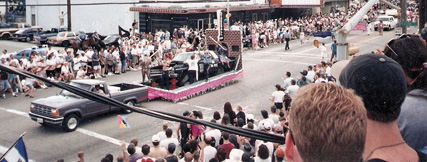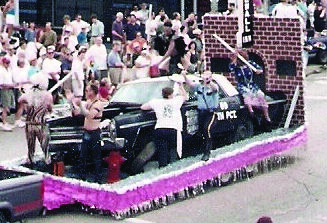Surprise! You’re a Legend!
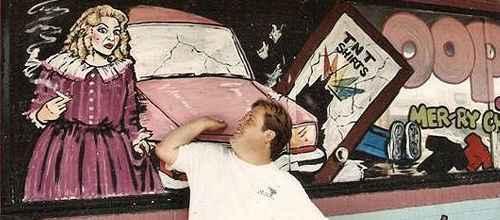
Scott Swoveland, the creator of the infamous mural painted on the exterior east wall of Houston’s legendary Mary’s bar, talks with OutSmart about his childhood, his love of art, and his days as a barback and window artist at Mary’s
by Brandon Wolf
In 1985, when Scott Swoveland arrived in Houston, fresh from his somewhat closeted life in Iowa, a friend greeted him with a case of champagne. “We finished about half of it off,” says Swoveland, “then he took me to Mary’s. Outside the bar, traffic was lined up, moving slowly down lower Westheimer. People were sitting on the cars, drag queens swished across the street, and couples were kissing in public. Inside the bar, the scene was wall-to-wall people. Underwear hung from the ceiling, and music shook the building.”
Swoveland’s friend turned to him and said, “Well, Dorothy, you’re not in Iowa anymore!”
After working at two other Houston clubs, Swoveland came to Mary’s in 1990, where he was hired as a barback. Mary’s owner, James “Fanny” Farmer, learning of Swoveland’s artistic talents, asked him to paint one of the weekly designs for the front window. Farmer was impressed. He asked the young artist to take over as permanent window artist.
Outback Remembrance Garden
Swoveland recalls Fanny Farmer’s 1991 passing. “We put his ashes in a very ornate urn and buried it in the Outback [the back lot behind Mary’s]. The next day we had a huge rainstorm. Gaye [Yancey, Mary’s co-owner] looked out the window of her office and
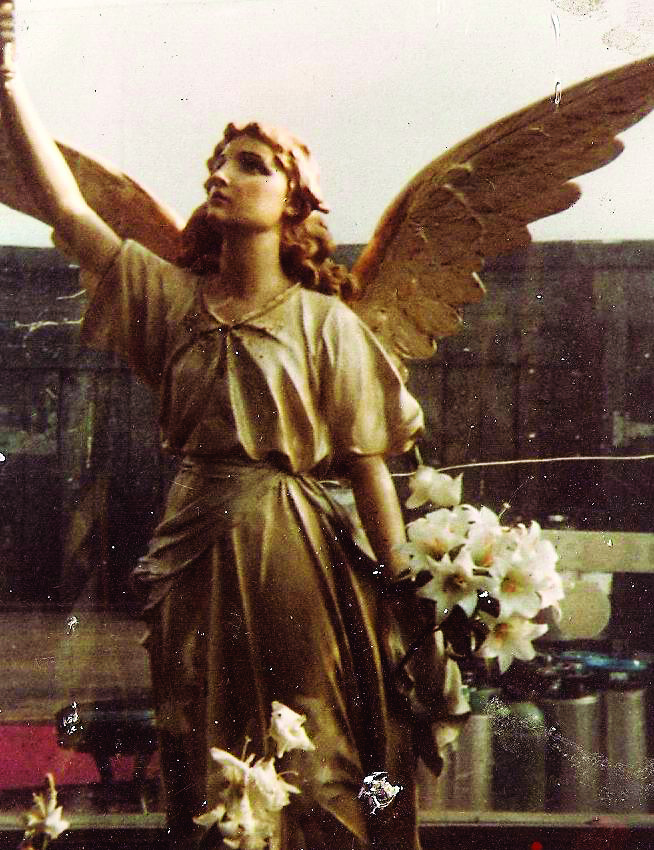
saw part of Fanny’s urn sticking out of the ground, pushed up by the saturation. She was quite freaked out about that. So we dug a deeper hole, put the urn back in, placed a cement block on top of it, and planted a tree over it.”
Swoveland remembers lots of memorial services. “We finally started calling them celebrations of life,” he says. “They were generally held inthe back lot. . . . That mound out back was actually built as a remembrance garden. It was meant to be a place for people who were sick or people who were hurting to find peace and comfort.”
Cracked Plaster and Nicotine Stains
When Swoveland first started at Mary’s, there was a nearly life-size plaster angel with a torch that lit up. “But over the years, it had fallen into disrepair; the torch didn’t work and it was yellow from nicotine,” he says. Given permission to restore it, he repainted it and re-wired the torch. “That angel was a beacon of hope,
especially for people who had been disowned by their families and their churches,” Swoveland says. “Mary’s angel was the only person left for them to pray to.”
Those famous Mary’s bar tops, with embedded pictures of Mary’s customers, was another of Swoveland’s restoration projects. “The main bar top was wood with glued-on photographs. Then a layer of urethane had been added. But over time, the finish had peeled back, and booze and water had seeped in.
“I saved as many of the original pictures as I could,” Swoveland says, “then we asked people to bring in new photos. I had a box of leftovers and decided to make a bar top for the patio bar.”
A “Public Art Masterpiece”
There were other projects, but Swoveland’s signature piece was the mural he painted on the outside east wall. It was painted as part of the 1997 Pri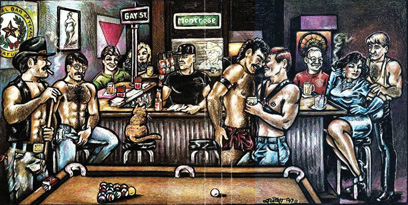 de Month celebration. The scene featured two hirsute leather men, some re gulars playing pool, others gathered at the bar, and Mr. Balls, Mary’s mascot cat. Swoveland says his intention was to create a true-to-life reflection of what might be going on inside Mary’s on any given day.
de Month celebration. The scene featured two hirsute leather men, some re gulars playing pool, others gathered at the bar, and Mr. Balls, Mary’s mascot cat. Swoveland says his intention was to create a true-to-life reflection of what might be going on inside Mary’s on any given day.
The mural was mostly painted over in 2006, leaving only Mr. Balls, perched on his bar stool, floating in a field of fluffy white clouds in a blue sky. Three years later, in 2009, Mary’s closed.
Declaring the lost mural “a public art masterpiece,” Houston artist Cody Ledvina and local art collective The Joanna used the figure of Mr. Balls as an anchor and, referring to photographs, repainted the mural in time for the 2011 Pride Parade. The property’s present owners say the mural wall will become a rotating public art exhibit when the Mary’s building is eventually remodeled to house a high-end coffee shop. Never fear, says Ledvina—plans are already under way to duplicate the mural elsewhere in the neighborhood.
The Making of the Artist
Long before he painted hairy-chested leather men, Swoveland drew Snow White, Cinderella, Mickey Mouse, and other characters he found in his collection of Disney book-and-record sets. Today, his mother still has those drawings he created in kindergarten.
As a Navy brat, the aspiring artist moved a lot during his childhood. “I attended seven different schools on the East Coast and then in Louisiana, before graduating from high school.” His art, he says, “was a great way for a shy kid to meet people at a new school. I would sit under a tree and start to draw, and soon more and more people would come up to see what I was doing.”
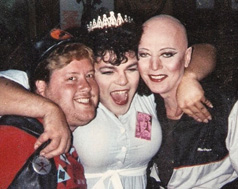
Mastering His Craft
Swoveland’s high-school art teacher challenged him with extra work in addition to regular classroom assignments. First, he worked on developing skill drawing faces, using a hairstyling book his teacher gave him. It featured photos of women’s faces with their hair pulled back. His next assignment was hair. He searched for images in celebrity magazines. “I especially liked Farah Fawcett’s big hair,” Swoveland remembers.
By the 10th grade, Swoveland was drawing fine lace, and his teacher said it was time to learn how to draw bodies. “Since no one in that part of West Virginia was going to pose nude for a 17-year-old, she told me to ask my father to buy me a copy of Playboy. He was overjoyed that I wanted a copy of the magazine,” he says. After a little convincing, his mother agreed to a Playboy subscription. For the remainder of high school, Swoveland’s models continued to be Playboy centerfolds.
Women Are Round, Men Are Square
After high school, Swoveland attended Northeast Louisiana University on a four-year Pell Grant work scholarship. “My first art teacher there was a closeted lesbian,” Swoveland says. “I had never drawn male figures before I took her class, so all my men ended up looking like women. Finally my teacher asked me if I was drawing drag queens. I didn’t even know what that was.” The advice she gave him was simplistic: “Round off every edge on a woman and square off all the edges on a man.”
To fulfill the work portion of his scholarship, Swoveland was assigned to the visual arts department. “I ended up working with the recruitment office, mostly preparing slide shows,” he says, “and I drew the school’s Indian mascot a lot of times!”
By the end of his junior year, Swoveland had taken all the art courses that were available. “I wasn’t interested in science and math, so I dropped out,” he says.
Life as a Gay Man
While dropping out of school, Swoveland was also coming out of the closet and learning where to meet others like himself. “The first gay bar I ever went to was named Xanadu and it was located in Leesville, Louisiana. For me, it was like Alice walking through the looking glass.”
After leaving school, Swoveland moved to Iowa to live with his parents. He picked up work as the manager of a straight “adult theater” and spun records in a gay bar in Waterloo. By 1985, he wanted passionately to get out of Iowa, and a friend in Houston invited him to come down and move in with him. And then there was Mary’s.
Life after Mary’s
Swoveland moved from Houston to Indianapolis in 1999, where he has lived ever since. Now 49, he works for a major retailer. Swoveland says he is “touched, humbled, surprised, and honored” by the restoration of his mural and the community reaction.
“I am a big believer and supporter of preserving our gay heritage. After all, if we have lived through the best and worst of times and don’t share our stories, then how will our young people who are starting their journey know where they came from, and the sacrifices of those who came before?
“I had fun working at Mary’s. It was a good ride, and I like to think in my own small way the community went along for the ride—and through those turbulent and often sad times, we saw light, love, and hope.”
Read the complete interview with Swoveland at OutSmartMagazine.com.
Brandon Wolf is a frequent contributor to OutSmart magazine.



